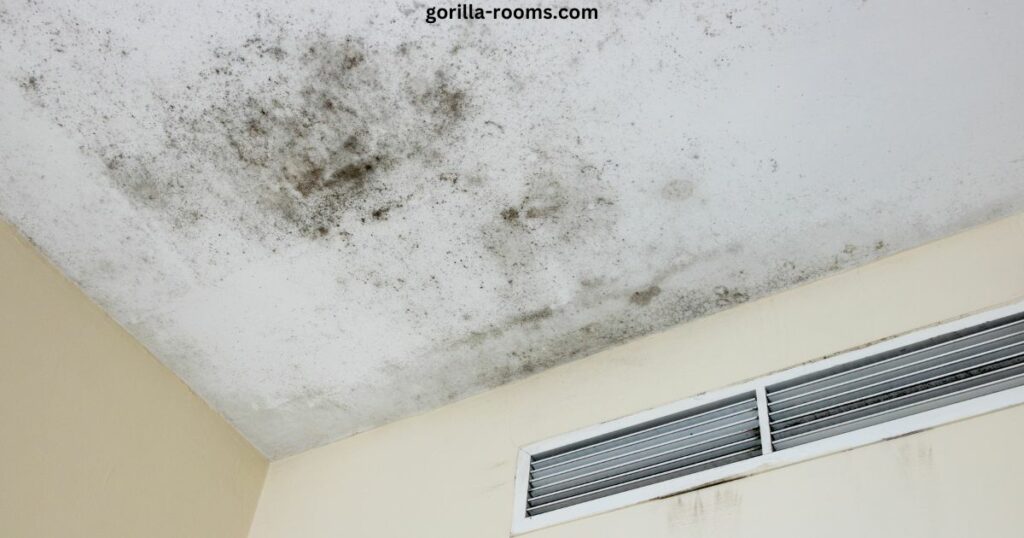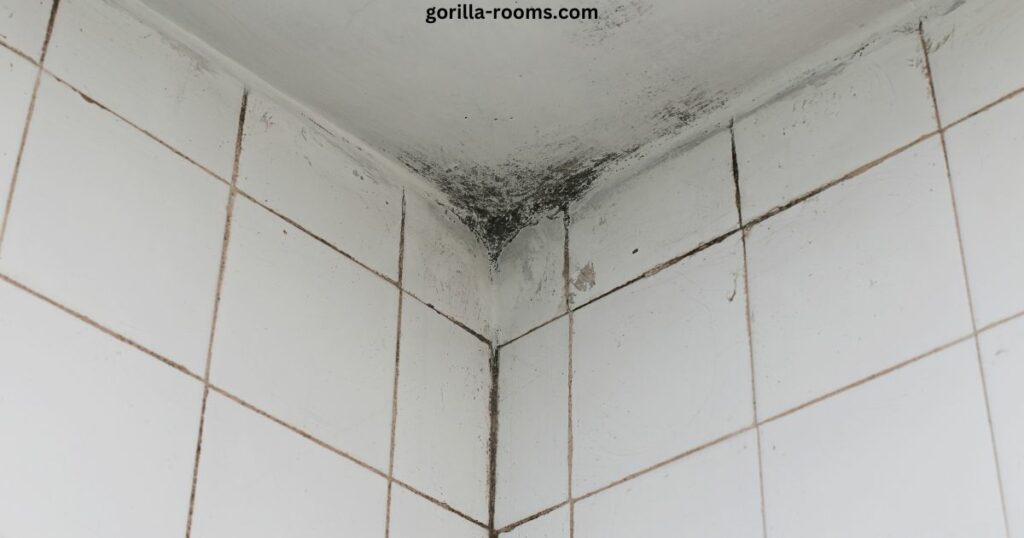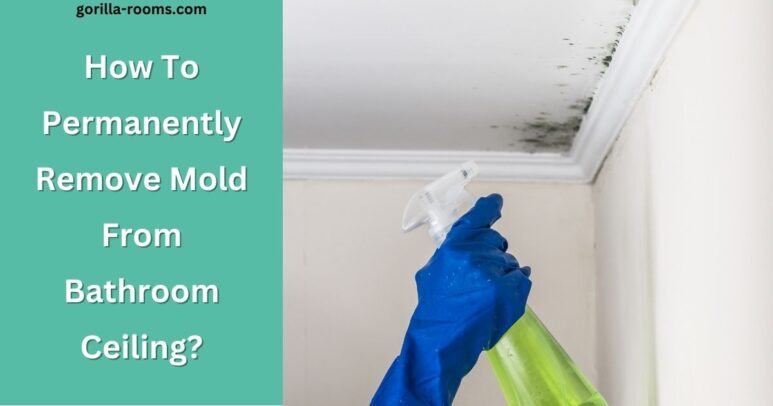Mold is unfortunately very common in bathrooms, as the wet and humid conditions create an ideal environment for mold growth.
You probably don’t think about cleaning the ceiling in your bathroom very often. Mold growth can occur in moist, dark areas, and the ceiling of your bathroom is prime location for these organisms, especially if you enjoy steaming hot baths.
To help you, I have shared my tips to remove mold from the bathroom ceiling. After reading this article, you will have a lot of tips to remove mold from various types of the bathroom ceiling. So let’s get to it!
How To Remove Mold From Bathroom Ceiling?
Don’t let ceiling mold ruin the look of your bathroom; instead, remove mold and mildew from your bathroom ceilings by following these steps:

1. Equipment for Safety
Mold removal is a serious business. Therefore, you should gather some safety supplies.
Eye protection, gloves, and a mask are required because the cleaning products can potentially harm your eyes and skin.
2. Prepare the Cleaning Solution
Bleach is a powerful ingredient for naturally removing mould from your bathroom ceiling. In a spray bottle, combine one part bleach with three parts water and shake the mixture vigorously.
3. Apply Cleaning Solution to the Affected Areas
Spray the mold and mildew on the bathroom ceiling with the cleaning solution. Keep an eye out for overspray dripping onto the floor.
4. Allow the Solution to Soak
Allow the bleach solution to soak thoroughly the moldy areas of the wall for about 10-15 minutes. Longer periods can cause damage to the ceiling, while shorter periods may be ineffective.
5. Scrub Lightly on the Moldy Area
Scrub the moldy area lightly with a scrub brush. Don’t scratch the ceiling, but apply enough pressure that the mold peels away without removing the paint.
If the stains are extensive or deep, the process may need to be repeated to remove all discoloration.
Moreover, the best way to permanently eliminate mold problems is to prevent moisture buildup in your home by adequately ventilating it at all times.
Some recommend purchasing a dehumidifier, but these units require regular emptying and cleaning and frequently increase energy bills.
How To Remove Mold From a Painted Drywall Bathroom Ceiling?

Mold is frequently found on drywall and painted interior walls, particularly in areas where moisture and humidity are present, such as kitchens and bathrooms.
Mold can begin to grow and penetrate the drywall if the drywall remains wet. When this happens, the drywall must be removed and replaced because it is impossible to remove all mold under these conditions.
Follow the steps given below to get rid of mold from a Painted Drywall:
1- Evaluate Wall Condition
If you notice bathroom mold on any interior walls, evaluate the wall’s condition and the extent to which the mold has taken over.
Begin by testing a small ceiling area with your chosen cleaning solution. If the paint is still in good condition, you should be able to clean the rest of the ceiling.
If the paint begins to peel or bubble, stop cleaning and seek further assistance from a professional mold removal service provider.
2- Protect The Surroundings
When cleaning mold from a painted drywall bathroom ceiling, take extra precautions to prevent mold growth. You’ll need to protect surrounding surfaces because you’ll use bleach or commercial mold-killing chemicals to remove the mold.
Cover the floor with plastic drop cloths and secure them with painter’s tape, so they don’t move. It never hurts to have some old towels and wear gloves on hand to catch any spills.
3- Apply the Cleaning Solution
It is time to apply a cleaning solution. A bleach/water solution removes mildew and mold from walls. Apply one part bleach to three parts water with a sponge or rag.
Suppose you use bleach and open windows and doors to allow the room to ventilate while you work. Wear rubber gloves and old clothing that you don’t mind getting ruined because bleach can cause fabric damage.
4- Rinse And let It Dry
Once the moldy areas have been treated, rinse the ceiling with clean water to remove any remaining bleach. Before painting or caulking the ceiling, let it dry completely.
How To Remove Mold from A Tiled Bathroom Ceiling?
If your ceiling is tiled, mold typically grows in the grout between the tiles, so removing it will require a little more elbow grease and a stiff-bristled brush.
Here are the steps to remove mold from a Tiled Bathroom Ceiling:

1- Mix a Cleaning Solution
In a bucket, combine one part bleach with four parts water. This solution can be applied with a sponge or poured into a spray bottle.
2- Saturate the Moldy Areas
Wearing old clothes and protective gear, stand on a sturdy stepladder and apply the solution to the moldy regions of the ceiling with a sponge. Apply liberally until the grout is completely saturated. It should be damp for at least 15 minutes.
3- Scrub Away the Mold
Scrub each grout line with a soft-bristled scrub brush to remove moldy residue. If stains remain, spray the area again, wait another 15 minutes, and scrub again.
4- Rinse and Dry
After removing all moldy residues, rinse the tiled area with clean water and dry it with a soft cloth. And that’s all there is to it!
Why Does Mold Grow on My Bathroom Ceiling?
Bathrooms are ideal places for mold and mildew to thrive. They grow when there is too much moisture in your bathroom.
To grow, mold and mildew only require oxygen, a food source, and moisture. They can damage bathroom fixtures such as drywall, trim, paint, doors, ceilings, and more because these fixtures are a food source for mold.
Most building codes now require a bathroom fan. Why? Because fans help to ventilate the room, eliminate odors, and remove moisture. The fan’s most crucial function is to remove moisture.
To prevent mold and mildew growth, keep your bathroom well-ventilated and use an exhaust fan regularly.
What Is the Best Product to Remove Mold?
Numerous products claim to remove mold, but good old soap and water are usually sufficient. You can also make a cleaning solution from these household items given below:
1- Borax
Borax, a white mineral powder, is an effective natural mold remover in the bathroom.
2- Bleach
Another effective method for mold stains in the bathroom is to use bleach. Make sure to open the window or turn on the exhaust fan when working with bleach.
3- Distilled White Vinegar
Distilled vinegar can be used to clean mold in the bathroom. Dilute it to clean tile floors or directly on your showerhead, drain, or toilet. While undiluted vinegar does not have a pleasant odor, it is an excellent mold cleaner.
Prevent Bathroom Ceiling Mold Returning
1- Entail Ventilation
Ventilation can be a major issue in bathrooms, particularly those without windows, but installing a ventilation fan can often reduce mold and mildew buildup.
Most bathrooms now have extractor fans to remove warm and moist air, but another option for you is you can increase ventilation in your bathroom by opening windows and doors.
Fans will remove odors and other contaminants while maintaining high air quality and, as a result, limiting bacteria growth.
2- Anti-Mold Paint
Anti-mold paint is a chemically treated wall and ceiling paint that prevents mold from growing even in areas with high condensation and air humidity.
It can be an excellent first step in preventing mold from returning after you’ve cleaned it away, as it creates a surface that repels condensation.
However, because anti-mold paint isn’t waterproof, you could still end up with water damage to your ceiling if it gets consistently wet.
3- Utilize Ceiling Cladding
Ceiling cladding is an excellent way to keep mold from growing on your bathroom ceiling. It’s becoming a more popular option, particularly in rented housing or hotels, because it’s simple to install and a stylish addition.
Unlike a plastered ceiling, which can absorb steam, PVC cladding will not absorb steam and thus will not become moldy.
When Mold Becomes a Problem?
If your bathroom has a musty odor and tiny black or white specks on the ceiling or walls, mold may grow behind the ceiling tiles or walls.
Some molds produce toxins, and hidden mold can cause health problems in otherwise healthy people.
When exposed to high levels of these toxins, you may experience symptoms such as:
- Fatigue
- Nausea
- Headaches
- Irritation of the lungs
- Irritation of the eyes
If your mold is causing you health problems, consult your doctor and hire a professional to investigate. If the mold growth in your bathroom isn’t too bad, use the steps above to clean it up and keep it under control.
How to Prevent Black Mold?
Black mold is among the most common bathroom molds and the most difficult to eradicate. It usually appears in spots or clusters and has a musty odor.
Unless you are allergic or asthmatic, black mold is no more dangerous to your health than other types of mold.
Black Mold can be avoided in your bathroom by taking preventative measures such as good ventilation, regular cleaning, and introducing purifying plants into your space.
However, if black mold has already taken hold, there are some things you can try to get rid of it:
- Undiluted white vinegar is an easy and inexpensive home remedy for black mold. As soon as you notice black mold forming, pour vinegar directly onto the affected area or use a spray bottle to apply it.
- However, because vinegar is not as strong as bleach or specialist mold remover products, it may not be able to remove stubborn black mold areas.
- Scrub difficult-to-reach areas with bleach on a cloth or an old toothbrush. When using bleach, wear rubber gloves and keep the bathroom well-ventilated.
FAQs
Why does mold keep coming back on the bathroom ceiling?
Mold grows on the ceiling due to moisture that has nowhere to go. Mold thrives in moist environments. Steam rises to the ceiling from hot showers and bathtubs; it can settle there without proper ventilation. Mold spores begin to grow again and again when moisture remains for an extended time.
Do mold sprays work?
No, because professional mold removal is a better choice.u003cbru003eMold removal methods must be effective at removing mold, safe for house occupants, and not have unintended consequences. Chemical sprays and other mold treatments do not meet these criteria.
Conclusion
Mold can be a recurring issue in bathrooms, so it’s essential to take preventative measures regularly. While prevention is preferable to cure, addressing mold when it appears is also critical; use the best cleaning products for proper bathroom maintenance.
These are some of the most basic methods for preventing mold formation in common areas such as the bathroom ceiling and between tiles. Mold can harm your health, so a thorough and regular bathroom cleaning routine is required.
Hopefully, this article has helped you find the solutions you need and understand the process for mold removal from the bathroom ceiling.

